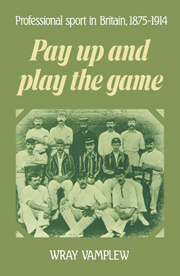Book contents
- Frontmatter
- Contents
- List of tables
- Preface
- Acknowledgements
- A guide to prices, 1870–1914
- Part I An overview
- Part II The development of professional gate-money sport
- 3 Popular recreation before the Industrial Revolution
- 4 Sporting activities and economic change, 1750-1830
- 5 The precursors of commercialised sport, 1830–75
- 6 The rise of professional gate-money sport, 1875–1914
- 7 From sports spectator to sports consumer
- Part III Sport in the market place: the economics of professional sport
- Part IV Playing for pay: professional sport as an occupation
- Part V Unsporting behaviour
- Part VI A second overview
- Appendices
- Notes
- Bibliography
- Index
3 - Popular recreation before the Industrial Revolution
Published online by Cambridge University Press: 16 February 2010
- Frontmatter
- Contents
- List of tables
- Preface
- Acknowledgements
- A guide to prices, 1870–1914
- Part I An overview
- Part II The development of professional gate-money sport
- 3 Popular recreation before the Industrial Revolution
- 4 Sporting activities and economic change, 1750-1830
- 5 The precursors of commercialised sport, 1830–75
- 6 The rise of professional gate-money sport, 1875–1914
- 7 From sports spectator to sports consumer
- Part III Sport in the market place: the economics of professional sport
- Part IV Playing for pay: professional sport as an occupation
- Part V Unsporting behaviour
- Part VI A second overview
- Appendices
- Notes
- Bibliography
- Index
Summary
Work in pre-industrialised Britain was more intermittent than it is today: for most workers there was no such thing as a regular working week or even a regular working day. A major reason for this lay in agriculture's dominance of economic activity. Work effort on the land would be greatest at planting and harvesting and less intense during other times of the arable year. Hedging, ditching, dung-spreading and threshing provided some winter and springtime employment but nowhere near the level obtaining from May to September. Similarly, in pastoral agriculture there would be peaks of activity associated with sheep-shearing and the autumnal slaughter of livestock. Agrarian pursuits were also subject to seasonal and irregular climatic influences: certainly in winter, frost, snow, heavy rain and fewer daylight hours reduced the amount of outdoor work which could be done.
Other economic activities were also subject to seasonal and irregular fluctuations. All trades, of course, suffered from the problem of demand - both its limited absolute level and its vicissitudes - but additionally there were specific supply side constraints. Processes utilising agricultural products would, within the limits set by the ability to hold stocks, fluctuate with both the aggregate and the seasonal supply of those inputs. The winter climate also enforced idleness on many trades, particularly where overland or seaborne transportation of goods was required. Hence building, quarrying, coal-mining, fishing, seafaring, repairing roads and shipbuilding, among others, reduced their level of activity as the weather worsened.
- Type
- Chapter
- Information
- Pay Up and Play the GameProfessional Sport in Britain, 1875–1914, pp. 21 - 32Publisher: Cambridge University PressPrint publication year: 1988



